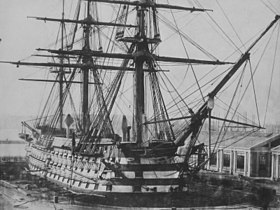HMS Duke of Wellington (1852)
 HMS Duke of Wellington |
|
| Overview | |
|---|---|
| Shipyard | |
| Order | 1841 |
| Keel laying | May 1849 |
| Launch | September 14, 1852 |
| Namesake | Arthur Wellesley, 1st Duke of Wellington |
| 1. Period of service |
|
| Commissioning | February 4, 1853 |
| Decommissioning | 1900 |
| Whereabouts | 1904 in Charlton scrapped |
| Technical specifications | |
| displacement |
5551 ts fully equipped |
| length |
73.1 m |
| width |
18.3 m |
| Draft |
7.6 - 8.2 m |
| crew |
970-1100 |
| drive |
Sails, 780 hp steam engine |
| speed |
10.15 knots max. (under steam) |
| Armament |
16 203 mm guns, 113 32 pounders and one 68 pounder |
The HMS Duke of Wellington was a full ship rigged first class ship of the line of the Royal Navy , which was only used for a short time in active naval service.
Construction and building history
The wooden ship of the line was originally to be called " Windsor Castle ", but was renamed in his honor on the anniversary of the death of the 1st Duke of Wellington . The decision to use a propeller was made after the fact that paddle wheels would have taken up too much space that was actually intended for guns. A used steam engine from Robert Napier & Sons and the propeller were retrofitted while the ship was still on the Helgen . For this, the ship was cut into two parts and lengthened.
During her construction, the Duke of Wellington was the largest ship in the world, but her design was already out of date. It largely corresponded to that of the ships of the line at the time of the Napoleonic Wars; only the dimensions of the ship were greatly enlarged compared to those of its predecessor around 1800. Because of the increase in aiming accuracy achieved a little later, the large number of heavy artillery carried along turned out to be obsolete.
Calls
Her first military service took place in 1854 in the Crimean War as the flagship of the Baltic Sea Fleet under the command of Vice Admiral Sir Charles John Napier , later under Rear Admiral Richard Saunders Dundas. She took part in the bombardment of Sveaborg in Russian Finland. Due to structural weaknesses and damage to the used machine, she was retired from active service in 1856 and served as a guard ship for the reserve fleet in Devonport from 1860 to 1863, as a protocol ship in Portsmouth from 1863 and as the flagship of the port admiral of the naval base in Portsmouth from 1869 to 1891 where it replaced the HMS Victory . In 1900 she was decommissioned, but still took part in the fleet inspection in 1902. In 1904 it was sold for scrapping.
Sister ships
Her three sister ships HMS Marlborough (1855) , HMS Prince of Wales (1860) and HMS Royal Sovereign (1857) received more powerful propulsion systems from the start, but they retired from active service around 1870; the Royal Sovereign was converted into a tower ship in 1864 .
